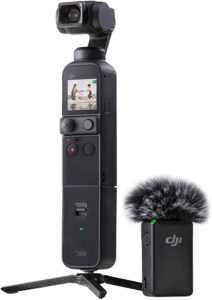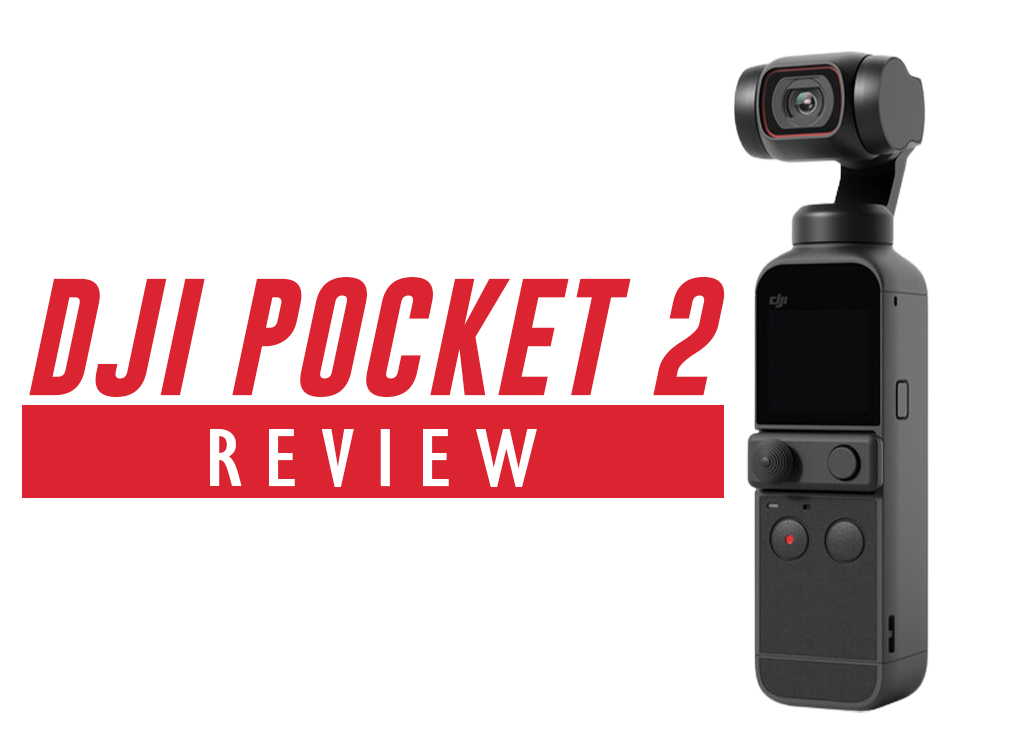DJI Pocket 2 is a direct follow up to the DJI OSMO Pocket which was released in 2018. The DJI Pocket series stabilized handheld vlogging cameras are manufactured with content creators in mind.
The DJI OSMO Pocket easily made it to the best cheap vlogging cameras as it met the needs of basic videographers. Of course it was not a perfect gadget and the DJI Pocket 2 tries to solve some of the issues in the previous generation.
The DJI Pocket 2 review will be looking into the features that come with this compact vlogging camera.
Let’s not waste any time and dive right in.
The DJI Pocket 2 Design
Our DJI Pocket 2 review will start off by the physical outlook of the compact video camera. If you have not read our DJI OSMO Pocket review, you may not tell the outright difference to the DJI Pocket 2. This is because the DJI’s concept in making the OSMO Pocket series is to create an all-in-one handheld compact camera with a 3-axis gimbal system.
The DJI Pocket 2 takes its rectangular 124.7×38.1×30 mm body design from the DJI Osmo Pocket.

When you purchase the DJI’s creator combo the vlogging camera comes with;
- a hard plastic cover
- a Do-it-all handle
- Tripod mount and a micro tripod
- Microphone transmitter and windscreen
- mini control stick
- wide angle lens
- USB-C smartphone adapter and lighting adapter
- USB Splitter charging cable
- a wrist strap and a sling strap
The camera has a small 1 inch square display with two buttons below it. Luckily there is a slider between the buttons and the screen on which you can attach a USB-C to connect to your phone for a bigger display.
The slider can also be replaced by a lighting mount or a mini control stick all which come with pricier DJI’s creator combo.
The power button is located on the right side assuming the screen is facing you. There is also a micro-SD slot on one side. A USB-C slot is located at the bottom of your DJI Pocket 2 where you can plug for charging.
Overall, the only visible difference the DJI Pocket 2 seems to have is a wider camera lens with a red stripe all around. This is where the DJI Pocket 2 packs a 1/1.7 sensor which improves on the quality of both pictures and videos.
Video Quality
DJI Pocket 2 is probably the best vlogging camera any content creator can get. It offers everything in DJI OSMO Pocket and so much more.
Let’s start off by image stabilization. DJI has mastered the craft of the 3-axis gimbal system which they largely use not only in their handheld products but also in the drones. For starters, a 3-axis gimbal system allows you to rotate an object along a single axis regardless of the movement by the person holding the gimbal.
These axes are pan (left- right movement), tilt (up-down movement) and roll. The DJI Pocket 2 has three modes based on these movements to create smooth footage. These modes are follow mode, tilt-lock and first person view (FPV) mode.
In follow mode, the camera remains horizontal no matter if you move the gimbal sideways. This means that both tilt and pan axis are active while roll is locked. In tilt lock mode, the axis can only move from left to right while the up-down movement is restricted. In FPV mode, all the axes move freely.
On to the camera, the DJI Pocket 2 offers a 93 degrees wide angle lens with a 20mm focal length and an aperture of up to f/ 1.8. These features enable a youtuber to comfortably take selfie videos without any cropping and with maximum lighting
With a bigger sensor size of 1/1.7, the videos captured in the DJI Pocket 2 are generally of better quality. A bigger sensor size means more details will be captured and enhanced low light performance.
The camera shoots in 4K/60fps and 1080p upto 50fps. DJI Pocket 2 can record super slow-motion of 1080p/240fps. Other modes include motionlapse, timelapse and hyperlapse. High Dynamic Range (HDR) in DJI Pocket 2 is something to look forward to after the firmware update.
I must also credit DJI Pocket 2 for excellent face tracking and autofocus capabilities. With a smartphone attached, you can simply box your subjects in the DJI mimo app and get valuable videos at different focal lengths.
Here is a sample video created by Andrew Hoyle from CNET;
Audio Quality
A good video requires a good sound quality and DJI Pocket 2 does just that. This compact vlogging camera has 4 microphones with directional audio soundtracking. Depending on which side you are, 3 on-body microphones will not record any voice leaving only the one closest to you for the job.
While the inbuilt microphones record quite decent audio while handheld, you might want to connect the wireless microphone if you will be further from the camera.
The external mic is connected by adding the Do-it-all handle onto your DJI Pocket 2, slide your screen down to access the settings, swipe to the left and go to the microphone icon, with your microphone on, tap on the icon to connect.
Picture Quality
If you intend to purchase the DJI Pocket 2 for photos, you would rather just use your smartphone for that. Don’t get it twisted though, the photos are quite decent since the camera captures either 16Mp or 64Mp shots. The photos look best when taken at a wide angle and lose focus as you zoom in.
With the advantage of a gimbal fixed on a tripod, the DJI Pocket 2 takes 3×3 and 180 degrees panoramas. The 3×3 panorama mode takes 9 images and stitches them to form a 5×7 image. On the other hand, the 180° panorama mode takes 4 images and stitches them to form one photo.
The camera also performs better in lowlight when taking photos than when shooting videos.
Battery Life
The DJI Pocket 2 houses a 875mAh non-removable battery just like the DJI Osmo Pocket. When shooting at 1080p, the battery can last up to 140 minutes and approximately an hour when in 4K resolution. The camera tends to be hot when you shoot in 4K for long though.
Remember the DJI Pocket battery is non-removable and you cannot replace it with a spare battery. However, you can charge it on the go while you are still shooting. The downside is that the camera will not be handheld if you still want those creative movements.
As for the memory card, the camera supports micro-SD up to 258GB and DJI recommends UHS-I speeds.
DJI Pocket 2 Price
The DJI Pocket 2 marketing strategy is quite clever. They have offered you two options in which you can buy the DJI Pocket 2.
The basic bundle costs $349 and comes with the camera itself, a protective case, USB-C and lighting adapters, mini-control stick, wrist wrap and a tripod mount.
The pricier creator combo comes with extra accessories such as the Do-it-all handle, wide-angle lens, USB splitter charging cable, micro tripod, wireless microphone receiver and a windscreen. This package goes for $499 which is fair compared to buying the accessories separately.
Overview of The DJI Pocket 2 Features
After an in depth review of the DJI Pocket 2, this is the summary of its specs;
- 1/1.7 CMOS sensor
- 100-6400 ISO range
- 4 microphones with soundtracking
- 93° wide angle lens
- 20 mm (f/ 1.8) Focal length
- 4K/60p, 2.7K/60p ,1080p upto 240 fps
- 64 Mp and 16Mp photos
- 875 mAH non-removable battery
- 1hr 4k 60fps, 140 minutes, 1080/24p
- Micro-SD upto 258 GB
- Weight 117g
Conclusion On The DJI Pocket 2 Review
DJI Pocket 2 is without any doubt the best value vlogging camera in the market. The compact camera is pocket friendly and you will hardly notice the 117g weight on your arms. Despite the small size, DJI Pocket 2 delivers high quality videos due to the technology packed. Of course there are downsides such as poor low light performance, tiny viewing screen and the fact that you cannot interchange the lens or the battery. But honestly, there is no gadget that can compare with the DJI Pocket 2. We can only wait and see what the DJI Pocket 3 has in store for us.

